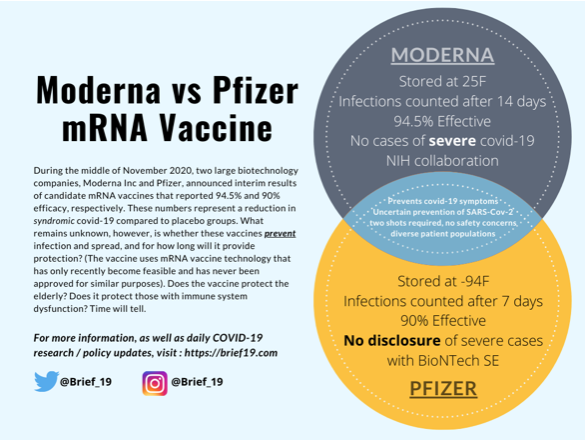RESEARCH BRIEFING
Yesterday, we released a briefing and analysis (see below) of news from the biotechnology company Moderna, which announced some key findings from its phase 3 covid-19 vaccine trial still in-progress. In addition, Johnson & Johnson announced the beginning of a large study it will conduct on a vaccine that uses a different technology than the two which have made headlines in the past two weeks (Pfizer being the other). Johnson & Johnson's trial will test whether its vaccine works safely and whether a booster second dose of the vaccine provides any incremental benefit, either in any effectiveness or in how long it provides any protection.
While all of the breaking news of the last 10 days remains preliminary, with the reporting of final data and implementation expected to take months, these are banner days for science. It is remarkable, for example, that Moderna was able to inject its first test subject on March 16th, merely two months after the genetic sequence became available in the early days of January of this year. While testing and therapeutics have suffered remarkable setbacks, the appearance of promising phase 3 trial data from at least two biotechnology companies in the same calendar year that a virus was first sequenced will certainly go down as a bright point in this otherwise dreadful pandemic year.
As we mentioned last week with our briefing on Pfizer's mRNA covid-19 vaccine, the short-term future of the country may be riding on an effective vaccine. A glimmer of hope was revealed last week as Pfizer and BioNTech released interim data from their phase 3 randomized clinical trial of an mRNA vaccine candidate that was reported to be "90% effective". Enter the 94.5% effective Moderna vaccine.
In breaking news today, the Cambridge, Massachusetts-based biotechnology company Moderna, Inc. (Nasdaq: MRNA) announced interim results of its phase 3 randomized clinical trial (RCT) of an mRNA vaccine candidate. In this trial, 30,000 individuals aged 18 years of age and older were enrolled and randomized to receive either the mRNA vaccine or a placebo injection on day 1 and day 29.
The primary outcome of the study was the number of participants with a first occurence of syndromic covid-19 occurring 14 days after the day 29 second dose of the mRNA vaccine, as well as incidence of side effects.
The data provided by Moderna today were limited. So far, we know that 95 cases of symptomatic covid-19 were detected, 90 of which were in the placebo group (i.e. those who did not receive the mRNA vaccine). There were a total of 11 severe cases, all of which occurred in the placebo group and zero in the mRNA vaccine group. The side effect profile was considered tolerable with only common vaccine side effects, such as pain at the injection site, fatigue, and aching muscles and joints noted.
How does this compare to last week's news that Pfizer/BioNTech covid-19 vaccine was "90% effective"? To summarize, in the Pfizer/BioNTech's vaccine results made public last week, 90% of participants who received the candidate vaccine did not develop symptomatic covid-19—though it remains possible that people who received the vaccine could still have contracted the SARS-CoV-2 virus but were asymptomatic carriers and vectors (i.e. could still spread) of the disease. We still don't know.
Key differences between the Moderna and Pfizer/BioNTech vaccine are described in the infographic accompanying this article. One advantage of the Moderna vaccine is that it can be stored in warmer conditions, including normal refrigeration up to 30 days. Another advantage includes increased effectiveness in preventing covid-19 symptoms (94.5% vs 90%). But both vaccine trials had similarities that are important to highlight, including large and diverse patient populations and the fact that overall no major safety concerns emerged. What we still do not know regarding the Pfizer vaccine is the exact breakdown of how many covid-19 cases occurred in the placebo versus the vaccine group, and how many cases of severe covid-19 occurred in the vaccine group. This is in contrast to information provided by Moderna that shared slightly more granular data.
What does this news mean? In one respect, little has changed. We still do not know whether these vaccines prevent infection and spread, and for how long protection lasts. (The vaccine uses mRNA vaccine technology that has only recently become feasible and has never been approved for similar purposes). Does the vaccine protect the elderly? Does it protect those with immune system dysfunction? Time will tell. On the other hand, we now have a second vaccine that targets the surface proteins of SARS-CoV-2 that shows signs of effectiveness. This ratifies the scientific community's general approach to developing a vaccine faster than at any time in human history.
